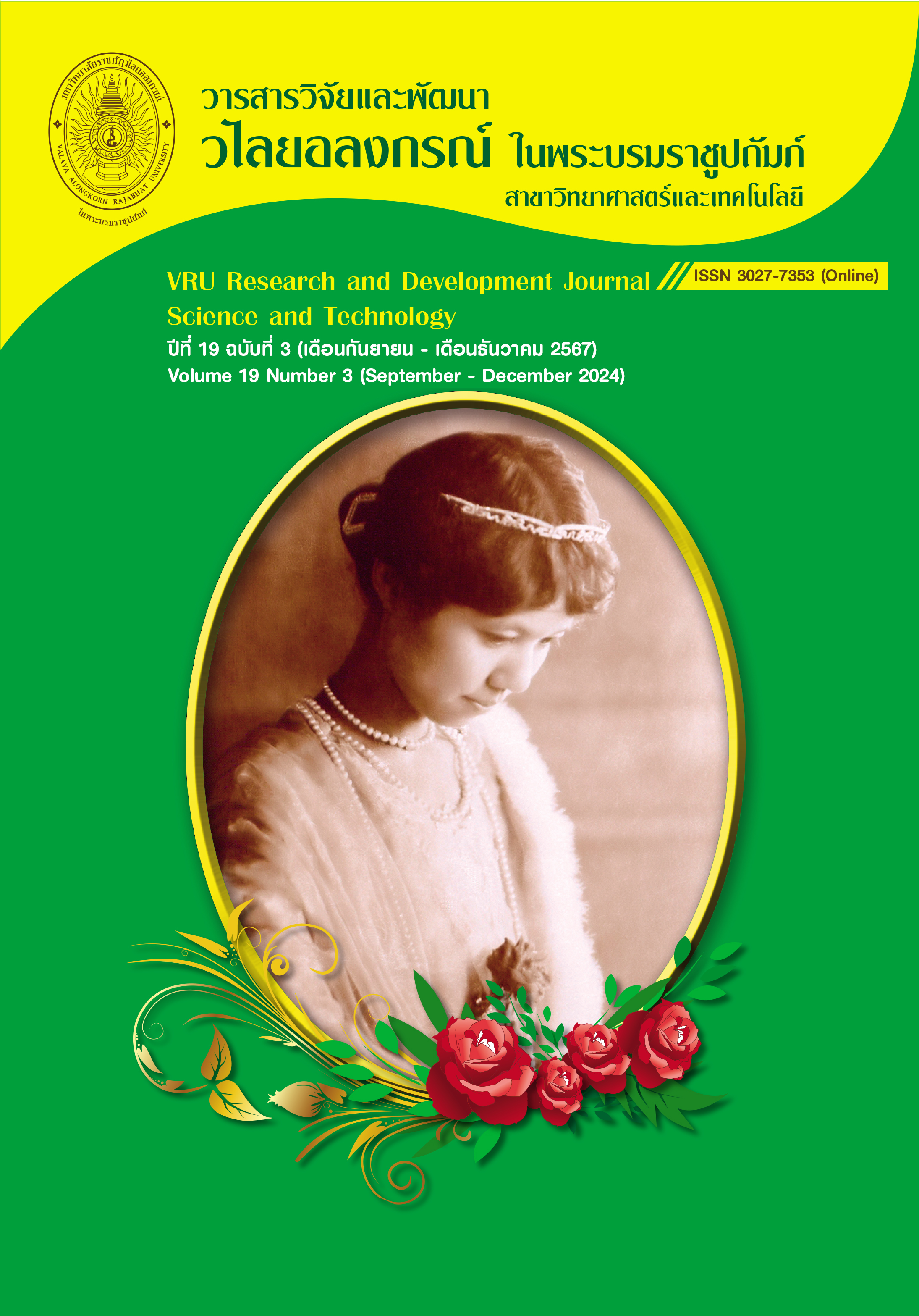PRODUCT DEVELOPMENT OF PROBIOTIC YOGURT FROM RICEBERRY RICE AND BLACK GLUTINOUS RICE MIXED WITH CEREALS
Main Article Content
Abstract
This research studied the quality of yogurt produced from two types of rice, Riceberry rice, and black glutinous rice. The experiment involved varying the proportion of rice used in three formulas: formula 1 consisted of 100% Riceberry rice, formula 2 comprised a 50:50 ratio of Riceberry rice to black glutinous rice, and formula 3 consisted of 100% black glutinous rice. Additionally, cereals including black sesame, black bean, soybean, and red bean were added in equal proportions to each formula. The products were analyzed for qualities including color values (L*, a*, and b*), texture characteristics (adhesiveness and cohesiveness), pH value, lactic bacteria content, yeast and mold count, total phenolic content, antioxidant capacity, and sensory evaluation. The results indicated that yogurt made from Riceberry rice exhibited the highest values for brightness (L*) and redness (+a*). Conversely, yogurt derived from black glutinous rice demonstrated the highest values for adhesiveness, cohesiveness, total phenolic content, and antioxidant capacity but had the lowest amounts of lactic bacteria and lactic acid content. All yogurt formulas contained lactic bacteria amounts ranging between 2.5 and 3.5 x 106 colonies per gram, a level beneficial for the human body. Moreover, the liking scores for all characteristics did not show significant differences (p>0.05), with the overall liking score ranging from slightly liking to moderately liking.
Downloads
Article Details
ลิขสิทธิ์บทความวิจัยที่ได้รับการตีพิมพ์เผยแพร่ในวารสารวิจัยและพัฒนา วไลยอลงกรณ์ ในพระบรมราชูปถัมภ์ ถือเป็นกรรมสิทธิ์ของสถาบันวิจัยและพัฒนา มหาวิทยาลัยราชภัฏวไลยอลงกรณ์ ในพระบรมราชูปถัมภ์ ห้ามนำข้อความทั้งหมดหรือบางส่วนไปพิมพ์ซ้ำ เว้นแต่จะได้รับอนุญาตจากมหาวิทยาลัยเป็นลายลักษณ์อักษร
ความรับผิดชอบ เนื้อหาต้นฉบับที่ปรากฏในวารสารวิจัยและพัฒนา วไลยอลงกรณ์ ในพระบรมราชูปถัมภ์ เป็นความรับผิดชอบของผู้นิพนธ์บทความหรือผู้เขียนเอง ทั้งนี้ไม่รวมความผิดพลาดอันเกิดจากเทคนิคการพิมพ์
References
จตุพัฒน์ สมัปปิโต, จิรพร ทูลภิรมย์, และณัฐหทัย ธรรมวาโร. (2562). การพัฒนาผลิตภัณฑ์โยเกิร์ตข้าวฮางข้าวเหนียวดำ. วารสารเกษตรพระวรุณ, 16, 229-245.
ไชยวัฒน์ ไชยสุต. (2556). โพรไบโอติก จุลินทรีย์ทางเลือกเพื่อสุขภาพ. พิมพ์ครั้งที่ 1. นนทบุรี: โรงพิมพ์สำนักงานพระพุทธศาสนาแห่งชาติ.
ณพัฐอร บัวฉุน. (2564). องค์ประกอบทางเคมีและฤทธิ์การต้านอนุมูลอิสระจากข้าวพันธุ์พื้นเมือง. วารสารวิทยาศาสตร์และเทคโนโลยี มรย, 2, 190-199.
ทิพย์วดี โพธิ์สิทธิพรรณ, และชุติมา คงจรูญ. (2563). การวิเคราะห์ความสามารถในการต้านการออกซิเดชันของน้ำพริกน้ำเงี้ยวในพื้นที่เขตภาคเหนือตอนบนประเทศไทย. วารสารวิจัยราชมงคลกรุงเทพ, 1, 138-144.
นิจฉรา ทูลธรรม, และชัยวุฒิ บัวเนี่ยว. (2562). ผลของปริมาณข้าวกล้องข้าวเหนียวดำงอกต่อการพัฒนา ผลิตภัณฑ์โยเกิร์ตในเชิงอาหารฟังชั่น. วารสารมหาวิทยาลัยศรีนครินทรวิโรฒ (สาขาวิทยาศาสตร์และเทคโนโลยี), 21, 114-129.
นิธิยา รัตนาปนนท์. (2557). เคมีอาหาร. พิมพ์ครั้งที่ 5. กรุงเทพฯ: โอเดียนสโตร์.
พันทิพา พงษ์เพียจันทร์, ธวัชชัย แถวถาทำ, และดำเนิน กาละดี. (2547). ปริมาณแกมมา-โอไรซานอลในผลิตภัณฑ์จากพืชชนิดต่าง ๆ. วารสารเกษตร, 20, 111-119.
ไพรัตน์ ศรแผลง, สุทธิพงศ์ อุริยะพงศ์สรรค์, เกรียงศักดิ์ พูนสุข, และพลสัณห์ มหาขันธ์. (2550). แลคติกแอสิดแบคทีเรียที่แยกได้จากมูลไก่พื้นเมือง. วารสารสัตวแพทยศาสตร์ มข., 1, 33-42.
ภัทธกร บุบผัน, รัตน์ติกร โกสุวินทร์, ญาธิป ชายหงส์, นพวรรณ ทรัพย์มังสังข์, และสุกฤตา อัภาราม. (2564). การพัฒนาผลิตภัณฑ์โยเกิร์ตจากน้ำนมข้าวสินเหล็กและการอยู่รอดของปริมาณเชื้อแบคทีเรียแลคติกในผลิตภัณฑ์โยเกิร์ต. วารสารมหาวิทยาลัยศรีนครินทรวิโรฒ (สาขาวิทยาศาสตร์และเทคโนโลยี), 26, 83-90.
สำนักงานมาตรฐานผลิตภัณฑ์อุตสาหกรรม กระทรวงอุตสาหกรรม. (2546). มาตรฐานผลิตภัณฑ์อุตสาหกรรมนมเปรี้ยว มอก.2146-2546.
วิษณุลักษณ์ คำยอง. (2550). คุณสมบัติของโยเกิร์ตน้ำนมข้าวโพดเสริมแคลเซียมแลคเตตหรือแคลเซียมกลูโคเนต. วิทยานิพนธ์ปริญญาวิทยาศาสตรมหาบัณฑิต สาขาวิชาเทคโนโลยีทางอาหาร, มหาวิทยาลัยแม่โจ้.
ศุภศิษฐ์ อรุณรุ่งสวัสดิ์, และนิอร ชุมศรี. (2558). การผลิตผลิตภัณฑ์คล้ายโยเกิร์ตจากข้าวกล้องงอก. Christian University of Thailand Journal, 21, 308-321.
สุธีรา ศรีสุข. (2559). การพัฒนาผลิตภัณฑ์โยเกิร์ตพร้อมดื่มจากน้ำนมลูกเดือย. วารสารวิทยาศาสตร์และเทคโนโลยี มรย, 2, 53-64.
อรอนงค์ นัยวิกุล. (2556). ข้าว : วิทยาศาสตร์และเทคโนโลยี. พิมพ์ครั้งที่ 3. กรุงเทพฯ: สำนักพิมพ์มหาวิทยาลัยเกษตรศาสตร์.
อุไรวรรณ วัฒนกุล, ศุภลักษณ์ สุดขาว, และพีรพงษ์ พึ่งแย้ม. (2561). คุณภาพทางเคมี-กายภาพ และสารออกฤทธิ์ทางชีวภาพในผลิตภัณฑ์ข้าวกล้องงอกหุงสุกเร็วจากข้าวกล้องงอกผสม 3 สายพันธุ์. รายงานการวิจัยคณะวิทยาศาสตร์และเทคโนโลยีการประมง มหาวิทยาลัยเทคโนโลยีราชมงคลศรีวิชัย.
Ahmed, S., & Hasan, M.M. (2014). Legumes: an overview. Journal of Pharmacy and Pharmaceutical Sciences, 2(1), 34-38.
AOAC. (2000). Official Methods of Analysis. (17th ed). Arlington Virginia: Association of Official Analytical Chemist International.
Chen, M.H., McClung, A.M., & Bergman, C.J. (2017). Phenolic content, anthocyanins and antiradical capacity of diverse purple bran rice genotypes as compared to other bran colors. Journal of Cereal Science, 77, 110-119.
da Silva, D.C.G., Brugnera, D.F., & de Abreu, L.R. (2013). Quantification of lactic acid bacteria and bifidobacteria in goat milk based yoghurts with added water-soluble soy extract. Global Journal of Food Science and Technology, 1, 91-97.
FAO, & WHO. (2006). Probiotics in food : Health and nutritional properties and guidelines for evaluation. Retrieved from https://www.fao.org/3/a0512e/a0512e.pdf
Fawzi, N.Y., Abdelghani, D.Y., Abdel-azim, M.A., Shokier, C.G., Youssef, M.W., Gad El-Rab, M.K., Gad, M.I., & Abou-Taleb, K.A. (2022). The ability of probiotic lactic acid bacteria to ferment Egyptian broken rice milk and produce rice-based yoghurt. Annals of Agricultural Science, 67, 107-118.
García-Ruiz, A., Cueva, C., González-Rompinelli, E.M., Yuste, M., Torres, M., Martín-Álvarez, P.J., Bartolomé, B., & Moreno-Arribas, M.V. (2012). Antimicrobial phenolic extracts able to inhibit lactic acid bacteria growth and wine malolactic fermentation. Food Control,
, 212-219.
Khoo, H.E., Azlan, A., Tang, S.T., & Lim, S.M. (2017). Anthocyanidins and anthocyanins: colored pigments as food, pharmaceutical ingredients, and the potential health benefits. Food & Nutrition Research, 61, 1-21.
Li, S., Tang, S., He, Q., Hu, J., & Zheng, J. (2019). Changes in proteolysis in fermented milk produced by streptococcus thermophilus in co-culture with lactobacillus plantarum or bifidobacterium animalis subsp. lactis during refrigerated storage. Molecules, 24, 1-13.
Lim, X. X., Koh, W. Y., Uthumporn, U., Maizura, M., & Wan Rosli, W. I. (2019). The development of legume-based yogurt by using water kefir as starter culture. International Food Research Journal, 26(4): 1219-1228.
Palencia-Argel, M., Rodríguez-Villamil, H., Bernal-Castro, C., Díaz-Moreno, C., & Fuenmayor, C.A. (2022). Probiotics in anthocyanin-rich fruit beverages: research and development for novel synbiotic products. Critical Reviews in Food Science and Nutrition, 1-17.
Posuwan, J., Prangthip, P., Leardkamolkarn, V., Yamborisut, U., Surasiang, R., Charoensiri, R., & Kongkachuichai, R. (2013). Long-term supplementation of high pigmented rice bran oil (Oryza sativa L.) on amelioration of oxidative stress and histological changes in streptozotocin-induced diabetic rats fed a high fat diet; Riceberry bran oil. Food Chemistry, 138(1), 501–508.
Tabasco, B., Sánchez-Patán, F., Monagas, M., Bartolomé, B., Moreno-Arribas, M.V., Peláez, C., & Requena, T. (2011). Effect of grape polyphenols on lactic acid bacteria and bifidobacteria growth: Resistance and metabolism. Food Microbiology, 28, 1345-1352.
Thuy, P.T., Trung, N.Q., & Huong, D.T. (2018). Agronomic characteristics, anthocyanin content, and antioxidant activity of anthocynins extracted from the seeds of black rice accessions. Vietnam Journal of Agricultural Sciences, 3, 208-219.
Valero-Cases, E., Cerdá-Bernad, D., Pastor, J.J., & Frutos, M.J. (2020). Non-Dairy fermented beverages as potential carriers to ensure probiotics, prebiotics, and bioactive compounds arrival to the gut and their health benefits. Nutrients, 12, 1-18.
Wang, Y., Wu, J., Lv, M., Shao, Z., Hungwe, M., Wang, J., Bai, X., Xie, J., Wang, Y., & Geng, W. (2021). Metabolism characteristics of lactic acid bacteria and the expanding applications in food industry. Frontiers in Bioengineering and Biotechnology, 9, 1-19.
Yamuangmorn, S., & Prom-u-Thai, C. (2021). The potential of high-anthocyanin purple rice as a functional ingredient in human health. Antioxidants, 10, 1-21.

